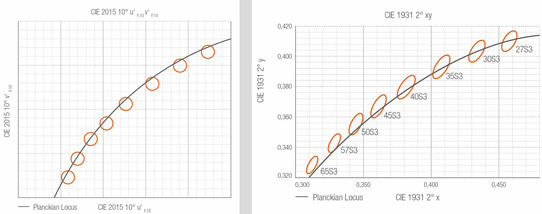Osram Opto Semiconductors GmbH of Regensburg, Germany says that its new TEN° binning provides the basis for what is claimed to be unprecedented color consistency for white LEDs, used for example as single-LED light sources in spotlights and downlights. To achieve this, the existing standard CIE 1931 2° xy color space has been supplemented with CIE 2015 10° u'v', recently developed by the International Commission on Illumination and implemented by Osram Opto as 10° binning. TEN° will be available on the market in the firm's third generation of the Soleriq S 13 LEDs as an additional feature beginning in March.

Picture - Left: TEN° binning in the 2015 10° u'v' color space.
Picture - Right: Standard three SDCM binning in the CIE 1931 2° xy color space.
Osram says that its new TEN° binning is differentiated from the established CIE 1931 2° color space in that it corresponds much better to the physiological perception of color, hence 10° binning. This is of particular interest for achieving uniform illumination from spotlights and downlights in which individual white chip-on-board (CoB) LEDs are primarily used. TEN° will first be used in the new generation of the Soleriq S 13 and will provide optimum color consistency in applications.
"Soleriq LEDs comply with current industry standards and remain completely compatible with existing white groupings," notes Alexander Wilm, key expert for General Lighting at Osram Opto. "TEN° binning is simply an additional property – and an extremely useful one," he adds.
When Soleriq LEDs that have been binned on the basis of these latest findings are installed in spotlights for example, it will be much easier to avoid differences in light colors compared with products grouped according to the old CIE 1931 2° standard, says Osram Opto. This results in fewer process stages for luminaire manufacturers which would otherwise be necessary due to different white color impressions in the ultimate application.
Osram noticed that two LEDs with the same color coordinates in the CIE 1931 2° color space could still exhibit noticeably different white tones, which resulted in the starting point for development activities to overcome this issue. One reason is for the difference is that the small rods responsible for color perception in the human eye are not evenly distributed, leading to different color perceptions even with LEDs in one SDCM binning with conventional metrics. This problem has been known and researched by scientists for many decades, but the results of their research have never been applied to general lighting. Osram says it has now changed that.





